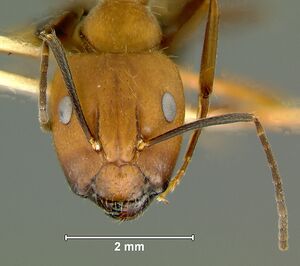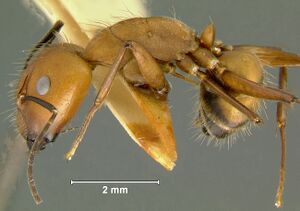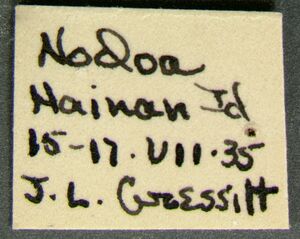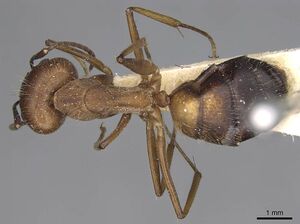AntWiki: The Ants --- Online
Photo Gallery
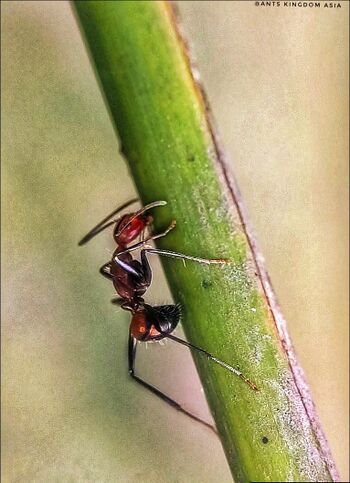
Camponotus nicobarensis worker. Photo by Ants Kingdom Asia.

Photo by Vladimir Zryanin.

Camponotus near
nicobarensis queen. Photo by Michal Kukla.
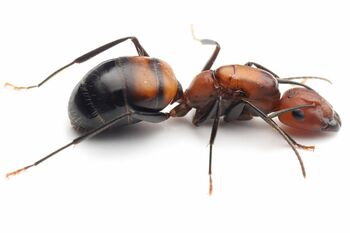
Camponotus nicobarensis queen. Photo by Taku Shimada.

Camponotus near
nicobarensis queen. Photo by Michal Kukla.
Identification
Keys including this Species
Distribution
Latitudinal Distribution Pattern
Latitudinal Range: 47.528713° to 14.378012°.
Oriental Region: Bangladesh, India, Laos, Nicobar Island (type locality), Thailand, Vietnam.
Palaearctic Region: China.
Distribution based on AntMaps
Distribution based on AntWeb specimens
Check data from AntWeb
Countries Occupied
| Number of countries occupied by this species based on AntWiki Regional Taxon Lists. In general, fewer countries occupied indicates a narrower range, while more countries indicates a more widespread species.
|

|
Estimated Abundance
| Relative abundance based on number of AntMaps records per species (this species within the purple bar). Fewer records (to the left) indicates a less abundant/encountered species while more records (to the right) indicates more abundant/encountered species.
|

|
Biology
|
|
|
|
X
|
|
|
|
|
|
|
|
|
| Jan
|
Feb
|
Mar
|
Apr
|
May
|
Jun
|
Jul
|
Aug
|
Sep
|
Oct
|
Nov
|
Dec
|
Source: antkeeping.info.
 Explore: Show all Flight Month data or Search these data. See also a list of all data tables or learn how data is managed.
Explore: Show all Flight Month data or Search these data. See also a list of all data tables or learn how data is managed.
Castes

Liu, C. et al. 2020. Ants of the Hengduan Mountains, Figure 25,
Camponotus nicobarensis.
Nomenclature
The following information is derived from Barry Bolton's Online Catalogue of the Ants of the World.
- nicobarensis. Camponotus nicobarensis Mayr, 1865: 31, pl. 1, fig. 1 (w.) INDIA (Nicobar Is).
- Type-material: syntype workers (number not stated).
- Type-locality: India: Nicobar Is, Kar Nicobar (no collector’s name).
- Type-depository: NHMW.
- Combination in C. (Myrmothrix): Forel, 1914a: 269;
- combination in C. (Myrmoturba): Emery, 1920b: 255;
- combination in C. (Tanaemyrmex): Emery, 1925b: 95.
- [Misspelled as micobarensis by Forel, 1892j: 229 (in key).]
- Status as species: Emery, 1889b: 513; Forel, 1892j: 240; Dalla Torre, 1893: 244; Emery, 1896d: 371 (in list); Bingham, 1903: 364; Forel, 1903d: 408; Forel, 1907e: 19; Wheeler, W.M. 1913e: 237; Viehmeyer, 1914a: 115; Santschi, 1920h: 174; Wheeler, W.M. 1921c: 545; Wheeler, W.M. 1923b: 5; Santschi, 1924c: 114; Emery, 1925b: 95; Wheeler, W.M. 1927d: 10; Donisthorpe, 1929a: 448; Mukerjee, 1930: 158; Menozzi, 1932d: 9; Menozzi, 1939a: 317 (in key); Teranishi, 1940: 68; Chapman & Capco, 1951: 249; Wang, C., Xiao & Wu, 1989a: 223 (in key); Wang, C. & Wu, 1994: 30 (in key); Bolton, 1995b: 113; Wu, J. & Wang, 1995: 179; Zhou, 2001b: 205; Jaitrong & Nabhitabhata, 2005: 15; Karmaly & Narendran, 2006: 95; Terayama, 2009: 216; Mohanraj, et al. 2010: 6; Ran & Zhou, 2011: 69; Guénard & Dunn, 2012: 29; Bharti, Guénard, et al. 2016: 25; Jaitrong, Guénard, et al. 2016: 28; Khachonpisitsak, et al. 2020: 43.
- Distribution: China, India (+ Nicobar Is), Indonesia (Sumatra), Malaysia (Peninsula), Myanmar, Taiwan, Thailand, Vietnam.
- Current subspecies: nominal plus monticola, rabbani.
Description
References
- Brassard, F., Leong, C.-M., Chan, H.-H., Guénard, B. 2021. High diversity in urban areas: How comprehensive sampling reveals high ant species richness within one of the most urbanized regions of the world. Diversity 13, 358 (doi:10.3390/d13080358).
- Dendup, K.C., Dorji, C., Dhadwal, T., Bharti, H., Pfeiffer, M. 2021. A preliminary checklist of ants from Bhutan. Asian Myrmecology 14, e014005 (doi:10.20362/am.014005).
- Dhadwal, T., Bharti, H. 2023. Two new species of the genus Camponotus Mayr, 1861 (Hymenoptera: Formicidae) with five new records from India. European Journal of Taxonomy 901, 1-51 (doi:10.5852/ejt.2023.901.2317).
- Emery, C. 1920b. Le genre Camponotus Mayr. Nouvel essai de la subdivision en sous-genres. Rev. Zool. Afr. (Bruss.) 8: 229-260 (page 255, Combination in C. (Myrmoturba))
- Emery, C. 1925d. Hymenoptera. Fam. Formicidae. Subfam. Formicinae. Genera Insectorum 183: 1-302 (page 95, Combination in C. (Tanaemyrmex))
- Forel, A. 1914a. Le genre Camponotus Mayr et les genres voisins. Rev. Suisse Zool. 22: 257-276 (page 269, Combination in C. (Myrmothrix))
- Khachonpisitsak, S., Yamane, S., Sriwichai, P., Jaitrong, W. 2020. An updated checklist of the ants of Thailand (Hymenoptera, Formicidae). ZooKeys 998, 1–182 (doi:10.3897/zookeys.998.54902).
- Liu, C., Fischer, G., Hita Garcia, F., Yamane, S., Liu, Q., Peng, Y.Q., Economo, E.P., Guénard, B., Pierce, N.E. 2020. Ants of the Hengduan Mountains: a new altitudinal survey and updated checklist for Yunnan Province highlight an understudied insect biodiversity hotspot. ZooKeys 978, 1–171 (doi:10.3897/zookeys.978.55767).
- Mayr, G. 1865. Formicidae. In: Reise der Österreichischen Fregatte "Novara" um die Erde in den Jahren 1857, 1858, 1859. Zoologischer Theil. Bd. II. Abt. 1. Wien: K. Gerold's Sohn, 119 pp. (page 31, pl. 1, fig. 1 worker described)
- Chantarasawat N., D. Sitthicharoenchai, C. Chaisuekul, and C. Lekprayoon. 2013. Comparison of Ants (Hymenoptera: Formicidae) Diversity in Dry Dipterocarp and Mixed-Deciduous Forests at Sri Nan National Park, Northern Thailand. Tropical Natural History 13(1): 1-19.
- Chapman, J. W., and Capco, S. R. 1951. Check list of the ants (Hymenoptera: Formicidae) of Asia. Monogr. Inst. Sci. Technol. Manila 1: 1-327
- Chen Y. Q., Q. Li, Y. L. Chen, Z. X. Lu, X. Y. Zhou. 2011. Ant diversity and bio-indicators in land management of lac insect agroecosystem in Southwestern China. Biodivers. Conserv. 20: 3017-3038.
- Chen Y., C. W. Luo, H. W. Li, Y. J. Liu, H. F. Zheng, and F. C. Yang. 2013. Investigation of ant species and distribution on Wuliang Mountain. Journal of Henan Agricultural Sciences 42(5): 118-122.
- Cheng D., Z. Chen, and S. Zhou. 2015. An analysis on the ant fauna of Jinzhongshan Nature Reserve in Gunagxi, China. Journal of Guangxi Normal University: Natural Science Edition 33(3): 129.137.
- Chhotani O. B., and P. K. Maiti. 1977. Contribution to the knowledge of Formicidae of the Andaman Islands. Zoological Survey of India 3(1): 17-20.
- Eguchi K., T. V. Bui, S. Yamane, H. Okido, and K. Ogata. 2004. Ant faunas of Ba Vi and Tam Dao, North Vietnam (Insecta: Hymenoptera: Formicidae). Bull. Inst. Trop. Agr. Kyushu Univ. 27: 77-98.
- Fellowes J. R., and D. Dudgeon. 2003. Common ants of lowland forests in Hong Kong, Tropical China. Proceedings of the 2nd ANeT Workshop and Seminar, p. 19-43.
- Fontanilla A. M., A. Nakamura, Z. Xu, M. Cao, R. L. Kitching, Y. Tang, and C. J. Burwell. 2019. Taxonomic and functional ant diversity along tropical, subtropical, and subalpine elevational transects in southwest China. Insects 10, 128; doi:10.3390/insects10050128
- Forel A. 1892. Les Formicides de l'Empire des Indes et de Ceylan. Part I. J. Bombay Nat. Hist. Soc. 7: 219-245.
- Forel A. 1903. Les fourmis des îles Andamans et Nicobares. Rapports de cette faune avec ses voisines. Rev. Suisse Zool. 11: 399-411.
- Forel A. 1907. Formiciden aus dem Naturhistorischen Museum in Hamburg. II. Teil. Neueingänge seit 1900. Mitt. Naturhist. Mus. Hambg. 24: 1-20.
- Ghosh S. N., S. Sheela, B. G. Kundu, S. Roychowdhury, and R. N. Tiwari. 2006. Insecta: Hymenoptera: Formicidae. Pp. 369-398 in: Alfred, J. R. B. (ed.) 2006. Fauna of Arunachal Pradesh. (Part -2). [State Fauna Series 13.]. New Delhi: Zoological Survey of India, iv + 518 pp.
- Guénard B., and R. R. Dunn. 2012. A checklist of the ants of China. Zootaxa 3558: 1-77.
- Hannan M.A. 2003. Ants of Bangladesh. ANeT Newsletter 6: 10-14.
- Hua Li-zhong. 2006. List of Chinese insects Vol. IV. Pages 262-273. Sun Yat-sen university Press, Guangzhou. 539 pages.
- Huong N. T. T., P. V. Sang, and B. T. Viet. 2015. A preliminary study on diversity of ants (Hymenoptera: Formicidae) at Hon Ba Nature Reserve. Environmental Scientific Conference 7: 614-620.
- Jaitrong W., and T. Ting-Nga. 2005. Ant fauna of Peninsular Botanical Garden (Khao Chong), Trang Province, Southern Thailand (Hymenoptera: Formicidae). The Thailand Natural History Museum Journal 1(2): 137-147.
- Jaitrong W.; Nabhitabhata, J. 2005. A list of known ant species of Thailand. The Thailand Natural History Museum Journal 1(1): 9-54.
- Leong C. M., S. F. Shiao, and B. Guenard. 2017. Ants in the city, a preliminary checklist of Formicidae (Hymenoptera) in Macau, one of the most heavily urbanized regions of the world. Asian Myrmecology 9: e009014.
- Li Q., Y. Chen, S. Wang, Y. Zheng, Y. Zhu, and S. Wang. 2009. Diversity of ants in subtropical evergreen broadleaved forest in Pu'er City, Yunnan. Biodiversity Science 17(3): 233-239.
- Li Q., Z. Lu, Z. Wei, M. Yanyan, and F. Ping. 2015. Communities of ground-dwelling ants in different plantation forest in arid-hot valleys of Jinsha river, Yunnan Province, China. Scientia Silvae Sinicae 51(8): 134-142.
- Li Z.h. 2006. List of Chinese Insects. Volume 4. Sun Yat-sen University Press
- Liu X. 2012. Taxonomy, diversity and spatial distribution characters of the ant family Formicidae (Insecta: Hymenoptera) in southeastern Tibet. PhD Thesis 139 pages
- Liu X., Z. Xu, N. Yu, and C. Zhang. 2016. Distribution patterns of ant species ( Hymenoptera: Formicidae) in Galongla Mountains and Medog Valley of Southeastern Tibet. Scientia Silvae Sinicae 52(11): 88-95.
- Lu Z., B. D. Hoffmann, and Y. Chen. 2016. Can reforested and plantation habitats effectively conserve SW China’s ant biodiversity? Biodivers. Conserv. DOI 10.1007/s10531-016-1090-1
- Lu Z., and Y. Chen. 2016. Effects of habitat on ant functional groups: a case study of Luchun County, Yunnan Province, China. Chinese Journal of Eco-Agriculture 24(5): 801-810.
- Menozzi, C. 1932. Formiche dell'Isola di Nias. Misc. Zool. Sumatr. 65: 1-13
- Mohanraj P., M. Ali, and K. Veerakumari. 2010. Formicidae of the Andaman and Nicobar Islands (Indian Ocean: Bay of Bengal). Journal of Insect Science 10: Article 172
- Mohanraj, P., M. Ali and K. Veenakumari. 2010. Formicidae of the Andaman and Nicobar Islands (Indian Ocean: Bay Of Bengal). Journal of Insect Science 10:172.
- Mukerjee D. 1930. Report on a collection of ants in the Indian Museum, Calcutta. J. Bombay Nat. Hist. Soc. 34: 149-163.
- Ogata K. 2005. Asian ant inventory and international networks. Report on Insect inventory Project in Tropic Asia TAIIV: 145-170.
- Presty J., and K. A. Karmaly. 2016. A study on the diversity and distribution of genus Camponotus Mayr (Hymenoptera: Formicidae) in Kerala: ecologically significant agents in ecosystems functioning. In: Chakravarhty A. K, and S. Sridhara (eds), Arthropod diversity and conservation in the tropics and sub-tropics. Springer edition. Pages 255-270.
- Qin F., S. Wei, Z. Zeng, S. Zhou, and X. Qin. 2008. Molecular phylogenetic research on five genera of Formicidae. Agricultural Science and Technology 9(5): 66-69.
- Ran H., and S. Y. Zhou. 2011. Checklist of Chinese Ants: the Formicomorph Subfamilies (Hymenoptera: Formicidae) (I). Journal of Guangxi Normal University: Natural Science Edition. 29(3): 65-73.
- Santschi F. 1920. Fourmis d'Indo-Chine. Annales de la Société Entomologique de Belgique 60: 158-176.
- Santschi F. 1924. Fourmis d'Indochine. Opuscules de l'Institut Scientifique de l'Indochine 3: 95-117
- Song Y., Z. Xu, C. Li, N. Zhang, L. Zhang, H. Jiang, and F. Mo. 2013. An Analysis on the Ant Fauna of the Nangun river Nature Reserve in Yunnan, China. Forest Research 26(6): 773-780.
- Terayama M. 2009. A synopsis of the family Formicidae of Taiwan (Insecta: Hymenoptera). Research Bulletin of Kanto Gakuen University. Liberal Arts 17:81-266.
- Terayama Mamoru. 2009. A synopsis of the family Formicidae of Taiwan (Insecta, Hymenoptera). The Research Bulletin of Kanto Gakuen University 17: 81-266.
- Terayama, M. 2009. A synopsis of the family Formicidae of Taiwan (Insecta; Hymenoptera). The Research Bulletin of Kanto Gakuen University 17: 81-266.
- Wang C. and Wu J.. 1992. Ants of the Jianfengling forest region in Hainan Province (Hymenoptera: Formicidae). Scientia Silvae Sinicae 28: 561-564.
- Wheeler W. M. 1913. Zoological results of the Abor Expedition, 1911-1912, XVII. Hymenoptera, II: Ants (Formicidae). Records of the Indian Museum 8: 233-237.
- Wu B., Y. Lu, G. Liang, and L. Zeng. 2010. Influence of the red inported fire ant, Solenopsis invicta Buren (Hymenoptera: Formicidae) on the diversity of ant communities in a newly infested longan orchard and grass areas nearby. Acta Ecologica Sinica 30(8): 2075-2083.
- Xu F. F., and J. Chen. 2009. Comparison of the Differences in Response to the Change of the Extrafloral Nectar-ant-herbivore Interaction System Between a Native and an Introduced Passiflora Species. Acta Botanica Yunnanica 31(6): 543-550.
- Xu Z., Zeng G., Liu T.-Y. and He Y.-F.. 1999. [A study on communities of Formicidae ants in different subtypes of vegetation in Xishuangbanna District of China.] Zoological Research 20: 118-125
- Yamane S.; Bui T. V.; Ogata K.; Okido H.; Eguchi K. 2002. Ant fauna of Cuc Phuong National Park, North Vietnam (Hymenoptera: Formicidae). Bulletin of the Institute of Tropical Agriculture Kyushu University 25: 51-62.
- Zhang R. J., L. W. Liang, and S. Y. Zhou. 2014. An analysis on the ant fauna of Nonggang Nature Reserve in Guangxi, China. Journal of Guangxi Normal university: Natural Science Edition 32(3): 86-93.
- Zryanin V. A. 2011. An eco-faunistic review of ants (Hymenoptera: Formicidae). In: Structure and functions of soil communities of a monsoon tropical forest (Cat Tien National Park, southern Vietnam) / A.V. Tiunov (Editor). – M.: KMK Scientific Press. 2011. 277 р.101-124.



 Explore: Show all Flight Month data or Search these data. See also a list of all data tables or learn how data is managed.
Explore: Show all Flight Month data or Search these data. See also a list of all data tables or learn how data is managed.